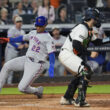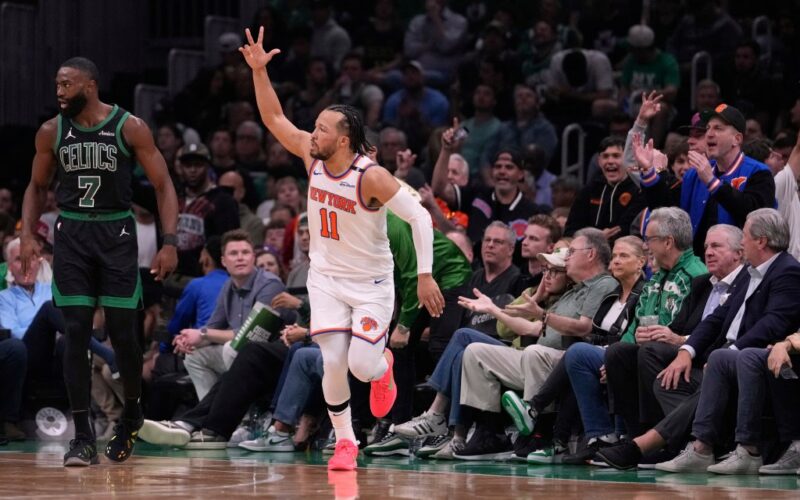Maybe the Indiana Pacers aren’t a fluke.
Maybe they’re for real.
Maybe building a roster for the long haul — one designed to win wars of attrition — is the true counter to teams stacked with top-heavy star power.
The difference between the two franchises meeting in the Eastern Conference Finals — nearly 25 years to the day since their last showdown — is clearest on the payroll.
The Knicks’ starting five — Jalen Brunson, Karl-Anthony Towns, OG Anunoby, Mikal Bridges, and Josh Hart — ranks among the most expensive in the league. Mitchell Robinson, their sixth man, makes eight figures. Miles McBride, the seventh, is on a three-year, $13 million deal. Everyone else? Situational at best. Cam Payne averaged under five minutes per game against Boston. Landry Shamet hasn’t cracked the rotation. Precious Achiuwa re-signed for $6 million and didn’t play in Round 1 — only logging minutes in Round 2 when the Celtics resorted to Hack-a-Mitch.
The Pacers, meanwhile, operate on a different model — the small-market model. The path of most resistance. A blueprint built on development and depth, not luxury. They don’t land the superstars who gravitate to the coasts. They build from the middle out — and they go deep.
Starting two-guard Andrew Nembhard just completed the final year of his rookie deal. Ben Sheppard, a steady contributor off the bench, is in Year 2. Bennedict Mathurin is in Year 3. Thomas Bryant plays on a veteran minimum. Only two Pacers make superstar money: Tyrese Haliburton and Pascal Siakam, both earning over $40 million. The next highest-paid player? Myles Turner at $19.9 million.
The Knicks lean on their stars. The Pacers spread the weight. The Knicks play seven. The Pacers play 10 — sometimes 11. And while this Knicks team is a different beast from the one Indiana eliminated in seven games last spring, the path to victory — and the road to ruin — hasn’t changed.
They’ll have to outrun, outgun, outlast and outthink a Pacers team that thrives on pace, piles up points and buries opponents before they can find their footing.
“It’s going to be a tough opponent. They push the pace. They run on makes, misses, and it’s going to be a huge communication series for us,” Hart said. “We are going to have to be locked in on every possession. Have to get back defensively. We can build off this game. I feel our communication was great [in Game 6 vs. Boston], and that’s something we can carry into that series. We just have to make sure we are prepared.”
Here were Indiana’s scoring totals in five games against the No. 1-seeded Cleveland Cavaliers: 114, 129, 104, 120, 121.
Before that, in Round 1 against the Milwaukee Bucks: 119, 129, 101, 123, 117.
And to close the regular season? 126, 115, 114, 104, 125 — plus a 140-point outburst against the Utah Jazz on April 4.
The pattern is hard to miss. Every so often, the Pacers stall. But most nights? They flood the scoreboard. When they’re humming, they don’t just score — they sprint. They turn games into track meets, fitting for a franchise named after speed. They’ll run you out of the gym. Drop 115, 125 — sometimes 150 — before you blink.
The Knicks better not blink — because all Indiana needs is one closed eye on defense to turn this series into a shootout.
“With a team like them, they get out in transition, they get a lot of threes up, and they play well together as a team,” said sixth man McBride. “So we just want to make sure we’re locked in, communicating, and understanding that we have to set a defensive presence.”
Indiana doesn’t just play fast — they weaponize pace.
Their guards — Aaron Nesmith and Nembhard — pressure 94 feet, guard with their hands, their chests, and their grit. They’re aggressive, physical, relentless — and they’ll be the next defensive hurdle for All-Star guard Jalen Brunson, who averaged 33 points and 10 assists on 53 percent shooting in three regular-season games against Indiana, including a 50 percent mark from downtown in those outings. He also torched them for close to 30 points per game in the second round last season.
“Style of play — and they’re an excellent basketball team. Strong on both sides of the ball,” head coach Tom Thibodeau said. “Their ability to push it in transition, that’s key. You’ve got to be great in defensive transition. When you look at the guard play — with [Tyrese] Haliburton, Nembhard, [T.J.] McConnell — they can all push and break you down off the dribble. So you’ve got to be very disciplined in your approach. They can spread you out. [Pascal] Siakam and [Myles] Turner are very talented bigs. We understand what the challenge is.”
The Knicks went 2-1 against the Pacers in the regular season. They won by 25, lost by 11, then bounced back with a 13-point victory heading into the All-Star break. But if this playoff run has proven anything, it’s that regular-season results are just numbers. Detroit won three of four against New York — then lost in six. Boston swept them — then collapsed twice with 20-point leads and bowed out in six.
“The important thing is to understand what goes into winning. It starts with your preparation,” said Thibodeau. “We have to know Indiana extremely well and just concentrate on being ready for that first game.”
This series isn’t about what happened before. It’s about what’s about to happen now — and the numbers to watch aren’t wins and losses. They’re 11 and 7.
The Pacers play 11 deep. The Knicks trust seven. The four players in between could swing the series — and Indiana will lean hard into that edge.
New York has a different one: the best two players on the floor. Stack the starting fives, and the gap at the top is crystal clear.
The Pacers have numbers. The Knicks have the talent.
Both are four games away from the NBA Finals.







